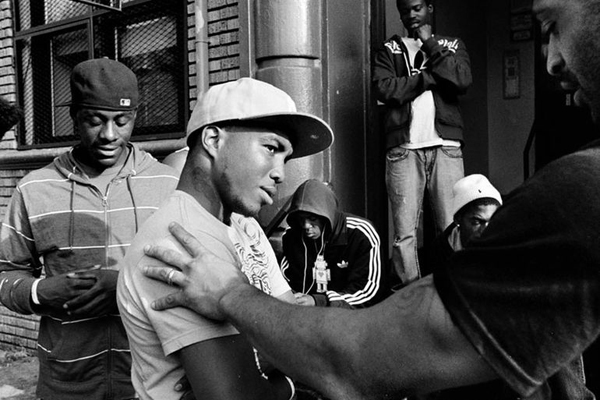
Features and Essays
Mike Hettwer: The Ship-Breakers (National Geographic) The men of Bangladesh risk their lives to tear apart cargo carriers and tankers | Related field notes by Hettwer here | From the May issue of National Geographic magazine
Sarker Protick: Of River and Lost Lands (PROOF) A project on Ishurdi district in Bangladesh
Ismail Ferdous and Nathan Fitch: The Deadly Cost of Fashion (New York Times) Short film dealing with last year’s Rana Plaza garment factory disaster in Bangladesh
Ami Vitale: Inside The (Not So) Secret World of Pandas (LightBox) Releasing Giant pandas into the wild in Sichuan Province, China
Ian Teh: Fight against malaria at the border between Myanmar and Thailand (Agence Vu)
Vincenzo Floramo: In Burma, It’s Rehab at Gunpoint (Foreign Policy) How Burmese rebels are waging war on the opium industry
Guy Martin: City of Dreams (Wired Raw File) Turkish soap operas and social unrest collide in surreal photos
Sergey Ponomarev: A Change in Atmosphere in Central Syria (New York Times) Relative calm in parts of Syria is deceptive
Monique Jaques: Female in Gaza (New York Times) Series on women of Gaza
Carl de Keyzer: To Be 20 Years Old in Rwanda (Le Monde) Photos of the country’s youth
David Guttenfelder: Rwanda: The Art of Remembering and Forgetting (National Geographic News) Two decades after the genocide, Rwandans navigate the way forward
William Daniels: Trapped in a nightmare in Central African Republic (Al Jazeera America) As the Central African Republic falls into barbaric violence between the country’s Christians and Muslims,23,000 refugees — traumatized, malnourished and dying — remain stuck in the town of Boda
Michaël Zumstein: Central African Republic spirals into chaos (MSNBC) Zumstein has been covering the growing crisis in C.A.R. since September 2013
Bieke Depoorter: After the Revolution: Interior Lives in Egypt (LightBox) Depoorter, a photographer based in Belgium, has found a way to uniquely document everyday Egyptian life
Dina Oganova: Faces of Georgia (The New Yorker’s Photo Booth) A selection from “I am Georgia,” an ongoing project that Oganova began in 2007.
Mauricio Lima: Russia’s Supporters Pile High the Barricades in East Ukraine (New York Times)
Manu Brabo: Crimea’s Self-Defence Force (Al Jazeera) Pro-Russian units say they are maintaining order in the breakaway region, but they have been accused of abuses.
Guillaume Herbaut: Return of the Cossacks (Paris Match L’Instant) Ukraine
William Albert Allard: Love and Loss on the Seine (National Geographic) The river is a lure for romantics, tourists, sunbathers, anglers, psychiatric patients—le tout Paris | From the May issue of National Geographic magazine
Angelos Tzortzinis: No Easy Comeback (New York Times) Economic struggles continue in Greece
Matt Black: The Geography of Poverty (Project website) Rural California
Christopher Payne: Isle of No Man (New York Times magazine) Photo from Payne’s book, North Brother Island: The Last Unknown Place in New York City
Megan Miller: Bitcoin (Wired Raw File blog) Photographer dives into the strange, subversive world of Bitcoin
Janet Jarman: Marisol: The American Dream (New York Times Lens blog) Jarman has followed Marisol from her childhood in Mexico to life as a young mother in the United States, making images that are educating teachers and doctors about the complexities of immigrant life

Amnon Gutman: Interrupting violence in Brooklyn (MSNBC) Outreach workers trying to reduce violence in the borough
Benedict Evans: A Place to Call Home (BKLYNR) Portraits of first generation Arab-Christian immigrants and their children in Brooklyn
Ilana Panich-Linsman: Growing up in beauty pageants (CNN Photo blog) An inside look at the real life of a preteen beauty queen.
An-Sofie Kesteleyn: My Little Rifle (New York Times Lens blog) The world of real guns for real kids
Edward Burtynsky: Water (Wired Raw File) Photos expose mankind’s uneasy relationship with water
Todd Heisler: A Journey North, From Farther South (New York Times) Hoping for asylum, migrants strain U.S. border
Daniel Berehulak: Grand Visions Fizzle in Brazil (New York Times) An array of lavish projects conceived when economic growth was surging now stand abandoned, stalled or wildly over budget.
Natalie Keyssar: In Venezuela, Youths Form the Backbone of Protests (Wall Street Journal)
Sebastian Liste: Life Inside New Palestine (Al Jazeera America) Thousands living like refugees in a tent camp known as New Palestine in southwest São Paulo as housing shortage grips the city while Brazil spends billions on World Cup
Santiago Arcos: La Ciénega (New York Times Lens blog) A chance mention of a small Ecuadorean town with no children and a handful of old residents set Santiago Arcos on a mission to document its dwindling life.
Articles
New York Times Wins Two Photography Pulitzers (New York Times Lens blog) The Times swept the 2014 prizes for photography. Tyler Hicks won for his coverage of a terrorist attack at a Nairobi mall. Josh Haner was honored for his images of the slow and painful recovery process of a Boston Marathon bombing survivor.
Four kidnapped French journalists have been freed (British Journal of Photography) French journalists, including photographers Edouard Elias and Pierre Torrès, have been found alive on the Turkish-Syrian border months after they were kidnapped
Photojournalist Kerim Okten killed in Turkey (NPPA)
Anja Niedringhaus Courage in Photojournalism Award Announced (PDN Pulse) The International Women’s Media Foundation has announced the creation of the Anja Niedringhaus Courage in Photojournalism Award, honoring the Associated Press photojournalist who was slain April 4 while covering preparations for the recent elections in Afghanistan.
Cheerful and Unflappable: Remembering the Photographer Anja Niedringhaus (Spiegel) Niedringhaus spent her life documenting wars, but she never allowed the difficult job to get the better of her. One of Spiegel’s own war correspondents commemorates the work of a longtime colleague killed in Afghanistan
Anastasia Taylor-Lind’s Maidan: Portraits from the Black Square (British Journal of Photography) Maidan: Portraits from the Black Square by Anastasia Taylor-Lind is a new book of portraits of anti-government protestors and mourners made in a makeshift photographic studio in Kiev, Ukraine during the recent unrest | Related on the Instagram blog here
Review: Peter van Agtmael’s Disco Night Sept 11 (Conscientious Photography Magazine)

Review: Edward Burtynsky’s Water (Photo-eye)
Here’s What Drone Attacks in America Would Look Like (Wired Raw File) On Tomas van Houtryve’s Blue Sky Days series
Rebecca Norris Webb: Rochester Reverie (American Photo magazine) Alex and Rebecca Norris Webb pay tribute to a city and the medium that put it on the map
Picturing the Holy Land: 12 Photographers Chart a Region’s Complexities (LightBox) This Place is the collective product, nearly a decade in the making, of 12 renowned photographers who each took up residence for a spell in Israel and the West Bank.
Art Photography vs. News Photography: Politico, Race and the “Other Washington” (BagNewsNotes) Comments on Politico’s edit of Susana Raab’s East of the River series
Daily Mirror’s weeping child picture is a lie and smacks of lazy journalism at best (Guardian) Paper’s use of stock shot of American child to illustrate splash about food banks in UK is betrayal of its photographic heritage | Guardian’s head of photography, Roger Tooth, on Daily Mirror’s recent use of a stock photo on its front page
The Subject of a Diane Arbus (The New Yorker’s Photo Booth) Diane Arbus’s Jewish Giant, a new exhibit that opens this Friday at the Jewish Museum in New York, explores the subject of one of Arbus’s most famous photographs, “A Jewish giant at home with his parents, in the Bronx, N.Y.,” from 1970.
From Ordinary Life, Extraordinary Images (New York Times Lens blog) Chang Chao-Tang didn’t think much of his images of everyday life in Taiwan. More than five decades later, an exhibit highlights the purity of his images, showing “real people and places.”
Gerda Taro: The forgotten war photographer you should know (CNN)
Featured photographer: Taylor Emrey Glascock (Verve Photo)
Featured photographer: Andrei Riskin (Verve Photo)
Featured photographer: Cassi Alexandra (Verve Photo)
Interviews and Talks
Q. Sakamaki Seeks the Soul Behind the Scene (PROOF) Sakamaki interviewed about his Instagram work
Tyler Hicks interviewed about his Pulitzer Prize winning work (CNN) Hicks about his Pulitzer winning photos of the Nairobi mall attack
Maggie Steber (NPPA) Jim Colton interviews Maggie Steber
Susan Meiselas (The United Nations of Photography)
Chernobyl Revisited: Q&A with Gerd Ludwig (Roads and Kingdoms)
David Turnley: Mandela, Struggle and Triumph, Part 1 | Part 2 (Leica blog) Two part conversation with David Turnley on his long-term project documenting Nelson Mandela and South Africa
David Turnley: Witness to History, Searching for Dignity (New York Times Lens blog) Turnley on his work documenting Rwanda genocide twenty years ago
Thomas P. Peschak: Discovering the Ocean of Childhood Dreams (PROOF)
Karen Mullarkey (Jarecke+Murion blog) Mullarkey is one of the most influential and respected picture editors of all time. She first worked at Life Magazine and went on to be the Director of Photography at Rolling Stone, Newsweek and Sports Illustrated.
Pamela Chen shares her journey into photography (The Verge YouTube)
Renée C. Byer on her work for Living on a Dollar A Day book (PROOF) Related on Dazed Digital here
Gregory Heisler (Esquire) Heisler on his Sports Illustrated cover showing 3,000 people pose before the Boston Marathon finish line
Rena Effendi on the Beauty in Unexpected Places (PROOF)
Ten questions for Martin Parr and Gerry Badger (Phaidon blog) Parr and Badger on rarity, collecting and why the photograph is like a time machine
Benjamin Lowy: “The end of Instagram?” (FLTR Live) Benjamin Lowy has covered wars in Iraq and Afghanistan, famine in Haiti and Darfur, and the aftermath of last year’s devastating tsunami. Yet in recent years he’s been recognised for his work on the iPhone. He speaks with Olivier Laurent about the impact it’s had on his work and his future
Benjamin Rasmussen (Vice / Mossless Magazine)
Five Questions for John Francis Peters (APhotoADay) John Francis Peters is a Los Angeles based photographer specializing in documentary, portrait, travel and lifestyle projects
John Edmonds (New York Times Lens blog) Turning Point interview
Mikko Takkunen is an associate photo editor at TIME.com. Follow him on Twitter @photojournalism.
More Must-Reads From TIME
- The 100 Most Influential People of 2024
- How Far Trump Would Go
- Why Maternity Care Is Underpaid
- Scenes From Pro-Palestinian Encampments Across U.S. Universities
- Saving Seconds Is Better Than Hours
- Why Your Breakfast Should Start with a Vegetable
- Welcome to the Golden Age of Ryan Gosling
- Want Weekly Recs on What to Watch, Read, and More? Sign Up for Worth Your Time
Contact us at letters@time.com